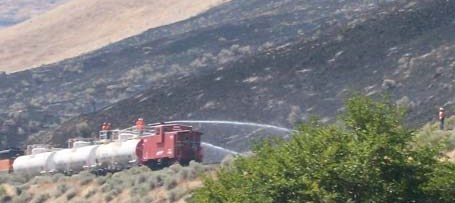
When we reported on the firefighting train that was used on the White Lightning Complex fire on August 23, 2010, it got us interested in trains as a piece of firefighting apparatus. It turns out that there is a lot more of this going on than we realized.
Railroads have firefighting trains for these types of incidents:
- to put out fires caused by their track grinding operations,
- to fight fires along their tracks in order to prevent the rail ties from burning and to protect their property,
- to suppress fires inside tunnels,
- rescue passengers in burning tunnels, and
- to put out fires that threaten to burn their bridges, trestles, and snow sheds (wooden structures covering tracks in the mountains)

In the United States firefighting trains are frequently called water cars or fire trains. Usually a fire train consists of an engine, several tank cars carrying 7,000 to 14,000 gallons of water each, and sometimes a caboose for transporting the employees or firefighters to operate the fire equipment. Most fire trains carry an assortment of fire equipment including hose reels, hand tools, nozzles, and hose. Sometimes each tank car will have it’s own pump and master stream nozzles, and they often have the ability connect the tank cars together with hoses so that the water can be shared between the cars. When a fire train has an engine at each end, the train can be split so that both ends of a trestle can be protected at the same time.
John Signor, when writing in his book Donner Pass:Southern Pacific’s Sierra Crossing, said this about the Central Pacific fire trains that worked in the Sierra Mountains in the late 1800’s:
They were equipped with a Duplex fire pump designed to deliver 300 gallons of water a minute through a 1,000 foot 2.5-inch hose. Each train was set up with two water cars, hose, and a complement of ladders, axes, buckets, and similar apparatus…Responding to an alarm, the trains would observe no speed limit other than what caution might dictate and they would blow a high-pitched steam siren continuously enroute to the fire.
During the summer months the fire trains in the Sierras were “under steam” at all times, staffed by crews ready to respond with the train to fight fire.
Russia has over 300 firefighting trains and recently used some of them during their fire bust in the Moscow region. Each water car on their trains has a capacity of 6,600 to 13,200 gallons.

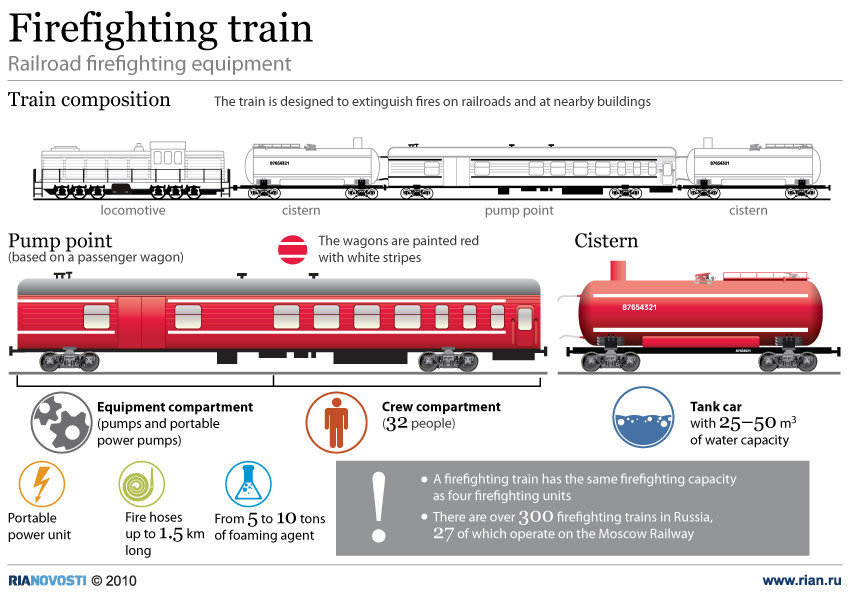
The Swiss have taken the concept of fire trains to a whole new level.
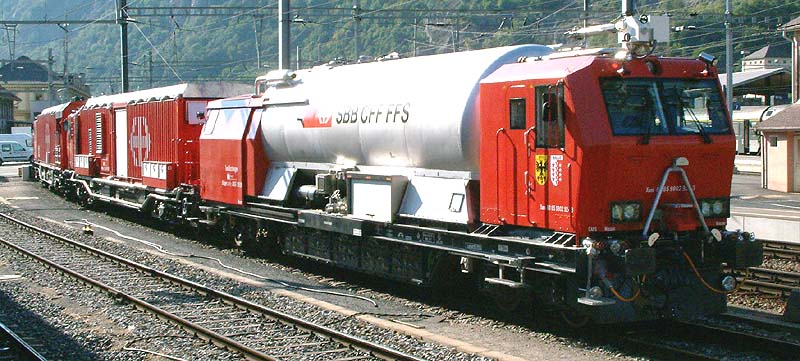
In Switzerland there are at least nine of these modern fire trains that started appearing on tracks in 2003 with eight of them being delivered in 2008. The primary purpose is to suppress fires in the many railroad tunnels and to rescue train passengers in burning tunnels. There are three components to the Swiss fire trains. The descriptions of the cars are from myweb.tiscali.co.uk/john.whitby/bBrig_lrz_index.htm:
- Equipment Vehicle: The Driving Cab of this vehicle will also normally be used as the control centre for the firefighting operations. The fire fighting monitors on the roof of this vehicle and the Fire fighting car can be controlled remotely from this cab. Foam and water connections are also provided outside the vehicle which enable hoses to be used to attack the fire. A self-protection device is also fitted to the vehicle to provide a water curtain should it be required to enter an area where the fire is burning close to the track. Breathing air bottles are stored in the roof of the vehicle to supply face masks in the driving/control cab and a slight overpressure can also be created in the cab to prevent the ingress of smoke. The onboard compressor can supply 1000 ltrs/min of breathing air at 300 bar pressure in order to replenish the bottles at the end of the operation. The compressor is powered by a 50 kW generator which also feeds the lighting and other electrical systems. The vehicle is driven by two diesel engines that provide approx. 660 kW of power.
- Rescue Vehicle: When the train reaches the incident the Rescue Vehicle can be detached and using its own diesel engines act as a shuttle to evacuate injured persons and other passengers to a safe location. The rescue container is supplied with breathing air from bottles mounted on the roof and can accomodate 9 casualties on stretchers or up to 70 people standing.
- Firefighting car (sometimes translated as “Fire Extinction Vehicle”): The unpowered Fire-fighting car is permanently coupled to the Equipment vehicle. It is equipped with a Driving Cab and can also be used as a control vehicle if required. A diesel-driven pump takes water from the 50 cubic meter [13,208 gallons] stainless steel tank and supplies the roof mounted monitors and the flexible hose connections. This pump is located in a compartment at the opposite end to the driving cab along with the Compressed Air Foam System (CAFS) and its associated tank. Breathing air is supplied to the Driving Cab from bottles mounted beneath the vehicle.
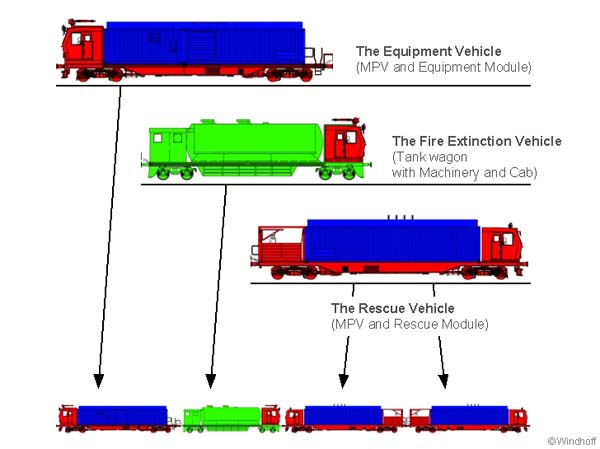

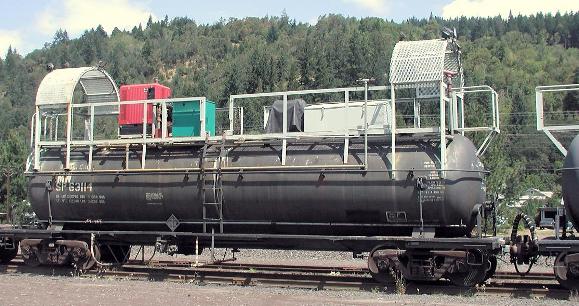
The majority of the rail grinding is done by private contractors (Loram, Speno, Harsco). These trains (?) come with tank cars and some have Class A foam capability as well. A few years ago in Spokane, WA the BNSF took a bulkhead flat car and converted it to a firefighting car with water, foam, pumps, hose reels and deck guns. They coordinated their efforts with WA’s DNR so fittings and everything worked ok. Not sure if if ever was used.
Forget hanging on to a bouncing brush truck while trying to put water on a moving grass fire (as I was doing last Thursday). I want to serve on a firefighting train! Which way to the dining car?